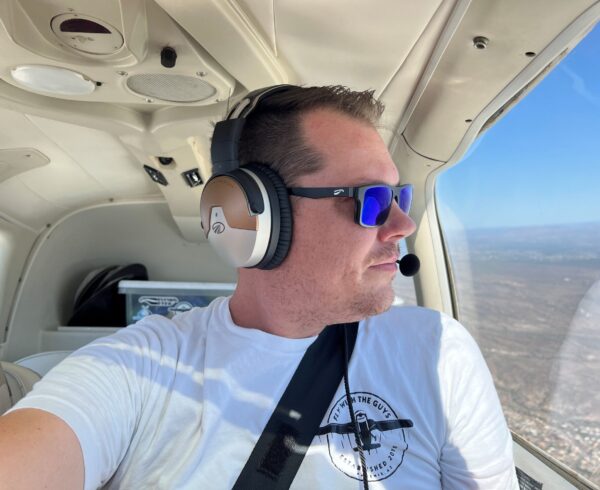You’ve seen them on the news: environmental reports from the air, flying over a flood area, an oil spill, or other environmental disasters. What the news reports don’t mention is that often those flights are provided by volunteer pilots who fly reporters, researchers, conservation organizers, and government officials in an effort to see and understand what’s happening in our natural world. That’s the mission of SouthWings, a volunteer pilot organization that provides partners with a unique perspective to better understand and solve pressing environmental issues in the Southeast U.S.
In many cases, the scope of environmental changes can only be fully comprehended from above. As SouthWings volunteer pilot Rankin Whittington points out, “While drones are used in environmental monitoring, their reach is very limited. My airplane provides the observation and photography platform that is required for large, sometimes massive areas of environmental interest.” Meredith Dowling, executive director of SouthWings and an environmental scientist and public policy specialist, agrees that the aerial perspective is critical. That’s why hundreds of partners rely on SouthWings, including conservation organizations, educational institutions, media organizations, and government and business decision-makers.




Dowling says that SouthWings volunteer pilots come from various backgrounds, including military service and commercial aviation. “They just need a valid pilot’s license, an aircraft—either rotor or fixed wing—and at least 750 hours PIC. She says SouthWings pilots appreciate that there’s no emergency with a SouthWings flight. “The landscape has to be visible, so it’s all VFR flying. Low stage, low pressure.”
Most SouthWings flights are for researcher partners, such as Dr. Alex Kolker, a hydrogeomorphologist (“he literally studies Mississippi mud”) and professor at Tulane University. SouthWings has provided flights for his research and for some of his graduate students. SouthWings has also flown journalists with every major national news organization and many international ones. Dowling says, “We’re not the experts, but we’re the experts in who the experts are. So, we can help pair journalists and decision-makers with knowledgeable folks who can really speak to the issues. For example, we flew a group of bank executives who were thinking about funding a particularly controversial form of coal mining called mountain-top removal. It’s generally not visible from the ground, but any pilot who has flown over these sites can tell you about the devastation. So, we were able to be part of their education process.”
SouthWings pilots are a diverse bunch. Jon Engle, of Charleston, South Carolina, is a former Air Force fighter and reconnaissance pilot. After retirement, he became a SouthWings volunteer, flying his World War II-era observation airplane. He says, “What I enjoy is the meaningfulness of each flight. One of my first missions involved flying a research scientist along the beach front where a restoration project had built a ‘groin’ (a series of rocks similar to a jetty) to reduce beach erosion. We flew over the site each month to photograph it with a digital camera that recorded precise GPS information, taking hundreds of images from different angles and altitudes. Concurrently, a research vessel recorded underwater radar imagery offshore. All the data was loaded into a special computer program by graduate students from the College of Charleston to create a 3-D image that could be manipulated and measured, and which showed the effects of the ‘groin’ along the beach, both above the waterline and underwater. It was a fascinating combination of photography, oceanography, geology, and advanced computer science, and my little 1942 airplane and I got to be a major part of it.”

Volunteer pilot Les Abend, of Flagler Beach, Florida, is a retired American Airlines pilot. He and his Piper Arrow are fairly new to SouthWings, but one of his favorite missions so far was flying a respected New Orleans chef over his Gulf food supply. “After dining at his restaurant, my wife and I gained a greater appreciation of the delicate balance between a healthy seafood meal and the effects of environmental intrusion.”
Rankin Whittingon, a lifelong pilot, thinks that growing up on a farm in Virginia and attending a Quaker college sensitized him to environmental issues. When he retired from a career in social services, he and his planes (a restored 1978 Cessna 182Q and a1999 Super Decathlon) went to work for SouthWings. One of his most memorable missions was flying over a mountaintop-removal strip mine near Beckley, West Virginia. His passengers were a reporter for National Public Radio, a photographer for Bloomberg News, and the head of Coal River Mountain Watch, an organization that promotes accountability for the companies operating mountaintop removal mines. He was happy when his flight resulted in some excellent press coverage of the environmental issues involved.
“Among volunteer pilot organizations, we’re unique in our focus on the environment and the natural world. If you’re passionate about protecting land and water for your children and grandchildren, this is a way to do it.”
Dowling says that many SouthWings pilots enjoy both the diversity of their missions and the diversity of people they get to work with, “people they would never have crossed paths with otherwise.” But most of all, they value the chance to make a difference for humanity and the planet. “In the context of GA, it’s a way to give back while doing something you really love. Among volunteer pilot organizations, we’re unique in our focus on the environment and the natural world. If you’re passionate about protecting land and water for your children and grandchildren, this is a way to do it.”















Leave a Comment